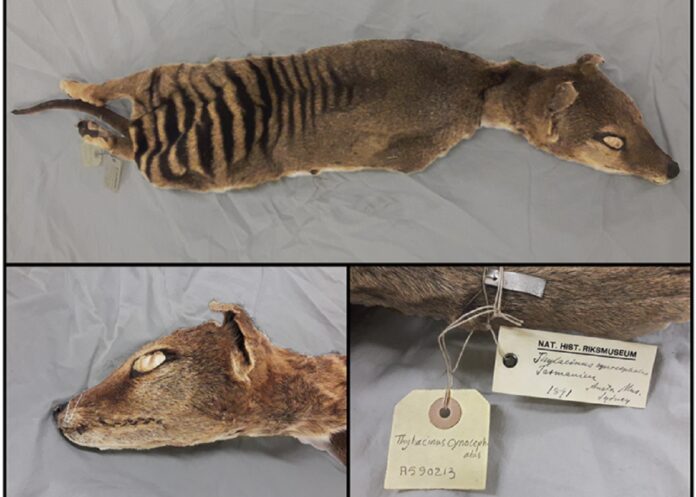A recent study successfully extracted and sequenced RNA from a century-old Tasmanian tiger specimen stored at room temperature in a museum. This allowed scientists to understand the genetic makeup of its skin and muscles. The findings could be crucial for reviving extinct species like the Tasmanian tiger and woolly mammoth and studying RNA viruses involved in pandemics.
The Tasmanian tiger, the thylacine, was a fantastic meat-eating marsupial. It used to live all over Australia and Tasmania. But when Europeans came, they considered it a pest and offered a reward of £1 for every adult thylacine killed by 1888. The last known Tasmanian tiger died in a zoo in 1936 in Tasmania.
Scientists are trying to bring back the Tasmanian tiger because its habitat in Tasmania remains preserved. This could help restore the balance in the ecosystem. But to do this, they need to understand the animal’s DNA and how its genes work, which they can study through its RNA.
Emilio Mármol, the lead author of a study recently published in the Genome Research journal by researchers at SciLifeLab in collaboration with the Centre for Palaeogenetics, a joint venture between the Swedish Museum of Natural History and Stockholm University, said, “Resurrecting the Tasmanian tiger or the woolly mammoth is not a trivial task, and will require a deep knowledge of both the genome and transcriptome regulation of such renowned species, something that only now is starting to be revealed.”
Researchers have studied RNA molecules from a 130-year-old Tasmanian tiger specimen. They analyzed the transcriptome of the skin and muscle tissues, finding gene expressions similar to living marsupial and placental mammals. The quality of the recovered transcriptomes was so good that they could even identify specific muscle and skin-related genes, as well as missing ribosomal RNA and microRNA genes, following recommendations from MirGeneDB.
Marc R. Friedländer, Associate Professor at the Department of Molecular Biosciences, The Wenner-Gren Institute at Stockholm University and SciLifeLab, said, “This is the first time that we have had a glimpse into the existence of thylacine-specific regulatory genes, such as microRNAs, that got extinct more than one century ago.”
This study brings exciting possibilities for museums with vast collections of specimens and tissues. Researchers may find and study RNA in these collections from extinct animals and RNA viruses like SARS-CoV2 in bat skins and other host animals. Love Dalén, a professor at Stockholm University, thinks this opens up new research opportunities. The study’s authors are looking forward to a new era in paleogenetics that goes beyond DNA, using both genomics and transcriptomics for holistic research.
In conclusion, The successful recovery of RNA from an extinct species represents a remarkable achievement at the intersection of biology and paleontology. This study contributes to our understanding of the Tasmanian tiger. It promises to unravel genetic mysteries from the distant past, further enriching our knowledge of the Earth’s evolutionary history.
Journal Reference:
- Emilio Mármol-Sánchez, Bastian Fromm, et al., Historical RNA expression profiles from the extinct Tasmanian tiger. Genome Research. DOI: 10.1101/gr.277663.123.
